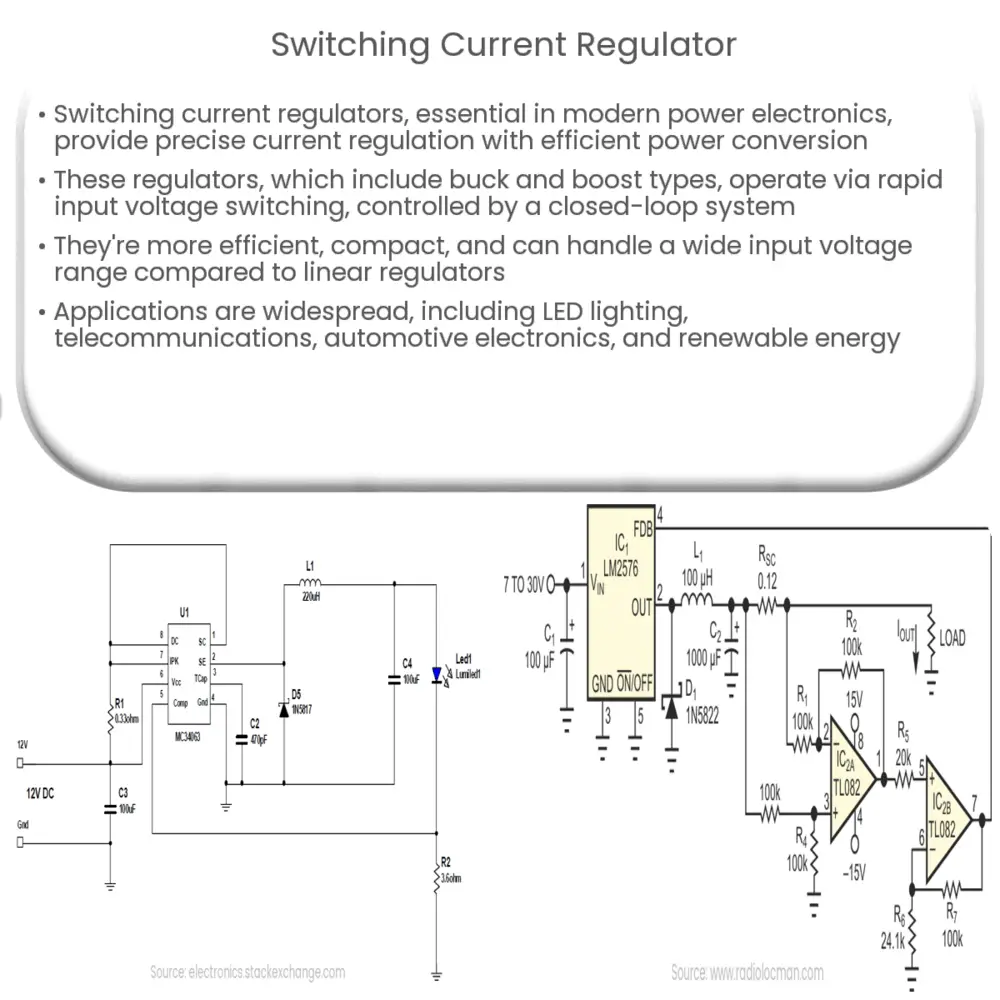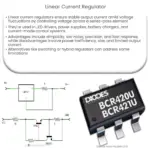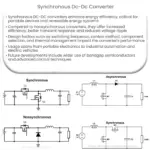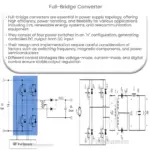Switching current regulators offer precise output current control, high efficiency, and compact design for various power electronics applications.

Switching Current Regulator: An Overview
Introduction
Switching current regulators have become an essential component in modern power electronics, particularly in applications where a stable and precise current output is required. These regulators offer efficient power conversion, compact size, and superior performance compared to their linear counterparts. In this article, we will delve into the fundamentals of switching current regulators, discussing their operation, types, and advantages.
Understanding Switching Current Regulators
Switching current regulators are power converters that maintain a constant output current, independent of variations in the input voltage or output load. They operate by rapidly switching the input voltage on and off, effectively controlling the output current. This switching action results in a high-frequency square wave, which is then filtered and smoothed to obtain the desired output current level.
These regulators are classified into two main categories: buck and boost regulators. Buck regulators, also known as step-down regulators, reduce the input voltage to a lower output voltage, while maintaining a constant output current. Conversely, boost regulators, or step-up regulators, increase the input voltage to a higher output voltage while still providing a constant current output.
Working Principle
Switching current regulators operate using a closed-loop control system that adjusts the duty cycle of the switching action to maintain the desired output current level. The duty cycle is the ratio of the time the switch is on to the total switching period. By adjusting the duty cycle, the regulator can effectively control the amount of power delivered to the output, thereby maintaining a constant current.
The control loop monitors the output current and compares it to a reference current. If the output current deviates from the reference value, the control loop adjusts the duty cycle accordingly to correct the output current. This continuous feedback mechanism ensures precise regulation of the output current, even in the presence of input voltage and load variations.
Advantages of Switching Current Regulators
Switching current regulators offer several advantages over their linear counterparts, including:
- Efficiency: Due to their switching operation, these regulators exhibit higher power conversion efficiency, resulting in less heat generation and reduced power dissipation.
- Compact size: The use of high-frequency switching allows for smaller passive components, such as inductors and capacitors, leading to a more compact and lightweight design.
- Wide input voltage range: Switching current regulators can handle a wide range of input voltages, making them suitable for various applications.
- Precision: The closed-loop control system ensures accurate output current regulation, even under varying input voltage and load conditions.
In the following sections, we will explore the different types of switching current regulators in more detail and discuss their applications in various industries.
Types of Switching Current Regulators
There are several types of switching current regulators, each with unique characteristics and advantages. Some common types include:
- Buck-Boost Regulators: These regulators combine the functionalities of both buck and boost regulators, enabling them to step up or step down the input voltage as required to maintain a constant output current. This makes them ideal for applications with a wide input voltage range.
- Isolated Switching Current Regulators: These regulators provide electrical isolation between the input and output, which can be crucial in applications where noise immunity and safety are paramount. They use transformers to achieve this isolation, ensuring that the output current remains constant even when the input and output are electrically separated.
- Synchronous and Asynchronous Regulators: Synchronous regulators use two active switches in their design, resulting in lower power losses and higher efficiency. Asynchronous regulators, on the other hand, use one active switch and one passive diode, which can result in slightly lower efficiency but simpler circuitry and lower cost.
Applications of Switching Current Regulators
Switching current regulators are used in a wide array of industries and applications, including:
- LED Lighting: These regulators are widely used in LED lighting systems to maintain a constant current, ensuring consistent brightness and longevity of the LEDs.
- Battery Charging: They are employed in battery charging circuits to provide a stable charging current, optimizing the charging process and prolonging battery life.
- Telecommunications: Switching current regulators are utilized in power supplies for telecommunications equipment to deliver precise and stable current levels, ensuring reliable operation of the devices.
- Automotive Electronics: These regulators are used in various automotive electronic systems, such as power steering, infotainment, and engine control modules, to provide a stable current supply for optimal performance.
- Renewable Energy: In solar and wind power systems, switching current regulators are employed to efficiently convert the variable input voltage from the energy source into a stable output current for charging batteries or powering loads.
Conclusion
Switching current regulators have emerged as a key technology in modern power electronics, providing efficient and precise current regulation across a wide range of applications. Their ability to handle varying input voltages and loads, coupled with their compact size and high efficiency, make them indispensable in industries such as LED lighting, telecommunications, automotive electronics, and renewable energy. With continued advancements in power electronics, switching current regulators will undoubtedly play an increasingly vital role in powering our world.




